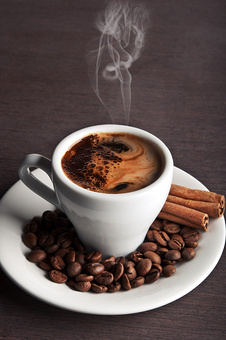2017 the most complete technical term for coffee roasting
Follow the caf é (Wechat official account vdailycom) and found that Beautiful Cafe opened a small shop of its own.
Flavor [Flavor] concatenates the above three to form a coffee impression. Some coffee has a variety of flavors, sour, sweet and bitter, while others are extremely sour, completely occupying your sense of smell and taste. There are also people who are used to using "feeling" to dominate judgment-does coffee have its own style? Does it have a unique forest or fruit aroma? Is your temperament gentle or masculine?

Acidity [Acidity] the taste of coffee left on the tip of the tongue after it is imported. The word "sour" looks eye-catching, but in fact, the original flavor and fresh vitality of coffee beans, like wine, are contained in its sour taste. The acidity of fresh coffee, with the aroma of fruit, is like the natural acid in lemon, grape, apple and other fruits, which is pleasant and fresh.
Mellow [Body]: the taste of the tongue after drinking coffee. The change of mellowness can be divided into light to light, medium, high, fat, and even as thick as syrup.
Odor [Aroma]: the smell and aroma emitted after the coffee has been prepared. The words used to describe smell include caramel, carbon roast, chocolate, fruit, grass, malt and so on.
Bitterness [Bitter]: bitterness is a basic sense of taste, and the sensory area is distributed in the base of the tongue. The bitterness of deep baking is deliberately created, but the common cause of bitterness is too much coffee powder and too little water.
Light [Bland]: coffee grown in lowlands, usually quite light and tasteless. Coffee with insufficient coffee powder and too much water will have the same light effect.
Salty [Briny]: after brewing, if the coffee is overheated, it will produce a salty taste.
The aroma of soil [Earthy]: commonly used to describe spicy and earthy Indonesian coffee, not the smell of dirt on coffee beans.
Fragrance [Aroma] the mellow aroma of coffee in the wandering air. From roasting, grinding to brewing, coffee beans try their best to release their fragrance at every stop of its long journey. Therefore, you might as well make good use of your sense of smell and experience this fragrant journey with coffee.
Uniqueness [Exotic]: describes coffee with its unique aroma and special flavor, such as flowers, fruits, and spices. Coffee from East Africa and Indonesia usually has this property.
Aromatic alcohol [Mellow]: used to describe coffee with good acidity balance.
Mild [Mild]: used to describe a coffee with a harmonious, delicate flavor, referring to all plateau coffee except Brazil.
Soft [Soft]: describes low acidity coffee such as Indonesian coffee, and also describes it as mellow or sweet.
Sour [Sour]: this sensory area is mainly located in the taste on the back of the tongue and is characteristic of light roasted coffee.
Spice [Spicy]: a flavor or smell reminiscent of a particular spice.
Roasting is a new advanced field for coffee practitioners, belonging to a new professional form. A mature roaster is not only good at baking boutique coffee, making it restore the most memorable taste and flavor.
Terminology for roasting and roasting of coffee
Equilibrium point
When the roaster is fully preheated and the internal temperature of the boiler is about 200 degrees, put the prepared raw beans into the furnace. At this time, the raw bean in the furnace will begin to endothermic reaction, and the internal tissue of the raw bean will begin to endothermic reaction, that is, the raw bean begins to absorb heat into its own body, so the temperature in the furnace begins to drop slowly, and when the temperature inside the furnace is gradually consistent with the temperature in the raw bean, it is called the equilibrium point.
At this time, it is one of the important links in the taste and aroma of coffee. If the balance is wavering, the flavor of coffee will become confused. Because the type of coffee roaster is different, the time of the balance point will be deviated, so the roaster should master the balance point of the roaster he uses. That is, the equilibrium point time corresponding to the amount of raw beans, the equilibrium point time corresponding to different seasons, the equilibrium point time of heat sources such as liquefied gas gas (LPG) or natural gas gas (LNG), the horizontal length of the inner and outer chimneys connected with the bean dryer, or the vertical height are all different, which should be carefully observed.
Temperature recovery point
After the equilibrium point, the furnace will remain unchanged for a few seconds or minutes. Then the temperature will warm up, and this point in time becomes the temperature recovery point. Although the recovery point of different models is different, the equilibrium point and temperature point of most semi-hot air and direct fire roasters are almost the same, that is, the temperature begins to rise slowly.
Generally speaking, there is about 30 seconds between the on-board equilibrium point and the return temperature point of the direct baking machine-one minute, and the temperature does not change. The semi-hot air will be converted to the temperature recovery point immediately after the equilibrium point.
After passing the temperature recovery point, the moisture of raw beans begins to evaporate, so it gives off a fishy smell, which varies according to the moisture content of raw beans and the size of firepower supply.
Light yellow spot
After the temperature recovery point, the temperature in the furnace began to rise slowly. In the case of high temperature baking, the light yellow spot is characterized by direct baking arriving in about 4 minutes, while semi-hot air or hot air appears in 6 minutes. The light yellow dot is also the time when raw beans change from raw bean flavor to sweet taste. the sweetness felt in the light yellow spot varies with the processing method of raw beans, and the sweetness of sun-cured raw beans is more obvious. In addition, the time of sweetness will vary depending on the water content of raw beans, and raw beans with water paste will be slower than those with low water content.
Yellow spot
When it comes to the yellow spot, the wrinkles on the surface of raw beans will gradually appear, which is a phenomenon caused by the evaporation of water in raw beans. In the endothermic reaction, the yellow dot is the time point at which water evaporates most. The density of raw beans also has an effect on the amount of wrinkles. For example, if raw beans with the same moisture content but different densities are baked at the same time, the raw beans with high density will produce more wrinkles than those with low density.
For example, the Brazilian bean of the new world bean variety has a moisture content of 10%, and there are fewer wrinkles on the surface of the original bean at the time of the yellow dot, while in the Kaddura species of Colombia, if the moisture content is 10%, the wrinkle of the original bean noodle will look deeper.
After burner
A device that uses a high thermal energy burner to reburn the smoke produced by a coffee roaster to eliminate smoke. At the same time, it can reduce the smell.
Net basket
The silver skin of Fujiga dust collector is a stainless steel basket. Can undertake more silver than the standard.
Transformers
The device that converts electric power into variable voltage and variable cycle number has the characteristics of control, stability, energy saving and so on.
Ignition transformer
An ignition device. It is used to ignite the burner of the roaster.
Stone remover
A device for sorting and removing stones and foreign bodies mixed with coffee beans according to specific gravity.
Large-scale maintenance
Guess disassembly and cleaning. Maintenance is carried out according to budget. And there is a half-year guarantee for maintenance products.
Stir
Stir and mix.
Cutting sharpening knife
The grinder that grinds coffee beans cuts them up by cutting. It is suitable for espresso and fine research.
Cup test
In order to detect the quality of coffee, coffee beans were roasted and then hot water was injected directly into coffee powder to observe its changes to identify coffee.
Lubricating oil
Industrial grease. Now take the food grade as the standard.
THERMAL
A safety device for overload protection of a motor.
Dust collector
The dust collecting device is used to recover the silver skin discharged by the roaster.
Inner pot
A drum for roasting coffee in a roaster.
Separate exhaust
When the standard roaster is driven by a motor for exhaust and cooling, the exhaust is baked separately from the cooled motor. It can improve the exhaust efficiency and the performance of continuous baking.
Longtian studio
Fujika Co., Ltd. Fuji Co., Ltd. Apply the mechanical technology accumulated over the years to the roaster and work together to develop a new type of roaster.
Exhaust baffle
It is used to control the heat flow in the roaster.
Midpoint
Drop the coffee beans to the lowest temperature after putting them in. According to the input temperature, the midpoint temperature will also change, so the baking process is controlled.
Direct fire type
The side wall of the inner pot with raw coffee beans is punched and processed, and the fire of the burner will come into direct contact with the coffee beans, so it is called direct fire.
Iron fan
Compared with aluminum fan (6 blades), iron fan (8 blades) can increase air volume by about 20%. Distinguish between the resistance of the chimney and the specially customized roaster.
Double inner pot
So that the flame will not directly touch the inner wall to make the inner pot into a double layer, there is an air layer in the middle, and a softer heat source can be baked.
Hot air type
The side of the inner pot is completely wrapped by iron, the back of the burner is punched, and the heat source produced by the lower burner is punched into the interior of the inner pot from the back of the inner pot and baked with the hot air produced by the burner.
Exhaust pipe
Smoke emitted during baking and its discharge pipe.
An explosion
At the end of the endothermic reaction stage and the first burst, the heat protection reaction is carried out immediately.
The sound produced by the expansion effect produced by the preheating of raw beans during the first burst, the sound and time of bursting will vary with the variety, density and vitality of the endothermic reaction stage. Under the condition of high temperature baking, direct fire baking will occur in 7 minutes, while semi-hot air or full hot air will occur in about 9 minutes.
An explosion represents the official beginning of the chemical reaction of raw beans. Generally speaking, we take continuous bursting as the starting point. Before that, there will be a single burst sound (when the tissue of raw beans changes, some raw beans will burst). Under this condition, please do not take a single burst sound as the basis. After a single burst sound, the continuous burst sound will begin soon, and this point in time can easily be used as the basis for the confirmation of an explosion.
After the explosion starts, you will smell a sour smell. With the passage of time, the sound of bursting becomes louder and louder, and you can feel that the sour taste is getting stronger and stronger, and the strength of this sour taste will vary from place to place. For example, raw beans at high altitude taste more sour than those at low altitude, and sun beans taste more sour than washed beans.
When the sour taste irritates to the depths of the nasal cavity, please reduce the firepower. If the firepower is not reduced and continues, the temperature will show a black curve and continue to rise; while after the nasal cavity is stimulated by sour taste, confirm and adjust the firepower, the temperature rise in the furnace will gradually slow down and show a blue curve.
The second explosion (the fire is not reduced in the first explosion)
As I just said, if the firepower is not adjusted when the explosion is dense, the temperature in the furnace will rise. If you use fresh raw beans with a water content of more than 10% for baking, the finished product with less firepower during the second explosion will have a brighter reddish brown than the original bean without firepower adjustment; if you use a direct-fire baking machine, you may have to adjust the firepower up at the same time or just before the second explosion. Because if the direct fire is not hot enough, it will cause the second explosion later, or the overall baking time will be prolonged. This situation has a bad effect on the taste and flavor of coffee, causing strong bitterness and its bitterness will stay in the mouth for a long time, resulting in a large loss of aroma.
The second explosion (reducing fire when the first explosion occurs)
After an explosion, the blue curve after firepower adjustment is reduced. The blue curve is relatively flat, on the whole, there is no downward trend, but shows a slowly upward trend. In case of a downward trend, it means that if the firepower is too strong, the beans baked in this case are darker, called dark black, bitter and aftertaste, and will become insipid and tasteless coffee.
Receiving plate
The part of the coffee roaster under the front cover is called the receiving plate.
Feeding hopper
Temporarily place a funnel container for coffee beans.
Mesh
Refers to the particle size of coffee beans after grinding by a bean grinder.
Important Notice :
前街咖啡 FrontStreet Coffee has moved to new addredd:
FrontStreet Coffee Address: 315,Donghua East Road,GuangZhou
Tel:020 38364473
- Prev

Which of the 12 constellations' exclusive coffee is your dish?
The 12 constellations like coffee and taste it in different ways. Will you drink your constellation coffee? Let's have a look. Aries love and hate clearly you, vitality is particularly strong, will not flinch, in order to match the rapid pace of Aries, a cup of passionate full-bodied Italian coffee (Espresso) is the ideal choice for Aries: 6 to 8 grams of fried Italy
- Next

Japanese coffee culture, the symbol of Japanese coffee culture
The coffee shop in Kyoto is quite charming. After coming out of the Yinge Temple, you can climb a few street corners and climb into the mountains for 20 minutes. There is a Maomao hidden in the mountains, which is a secret shop spread by word of mouth of coffee maniacs. In Shu Guozhi's book "A layman's Kyoto", there is an article "sitting in a Cafe in Kyoto", which mentions cafes in the ancient capital, some of which have been in operation for decades, while others hide in the corners of historic buildings.
Related
- What documents do you need to go through to open a coffee shop? coffee shop coffee shop certificate processing process
- How to purchase Coffee beans in small Cafe how to choose a suitable supplier for domestic Coffee supply Company
- How to drink Starbucks Fragrance White Coffee? how to make Australian White Coffee? what Italian coffee beans are recommended?
- The Story of Flora Coffee: the name of Flora Coffee Bean and the implication of the Flowers on Florna Coffee
- How much does a cup of coffee cost? How much is the profit of a cup of coffee? What is the profit of the coffee shop in a year?
- Yunnan small Coffee, known as "fragrant Coffee", introduces the characteristics of Alpine Arabica Coffee producing areas in Yunnan, China
- 2023 latest Starbucks full menu price list how much is a cup of Starbucks coffee what is better to drink the most popular hot and cold drinks recommended
- Starbucks different kinds of Coffee Price list Starbucks menu 2023 Top Ten Best drinks in Starbucks
- Starbucks Spring praise Comprehensive matching Coffee Bean theme Story Packaging implication and taste description
- The cost of a cup of coffee latte American coffee cost price and selling price

